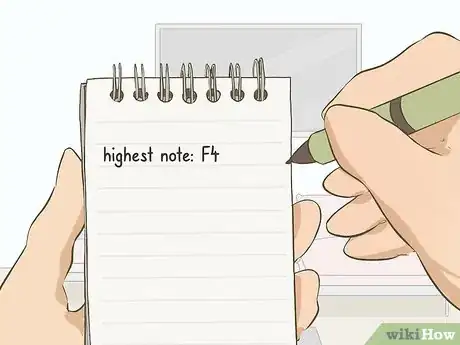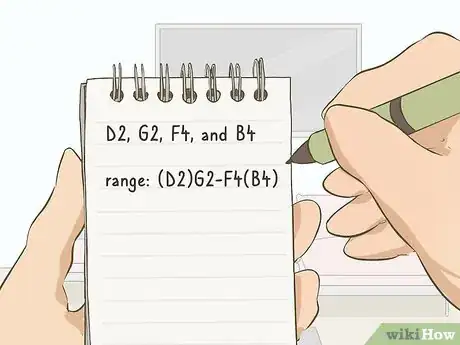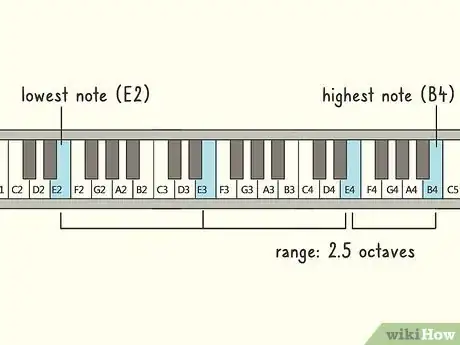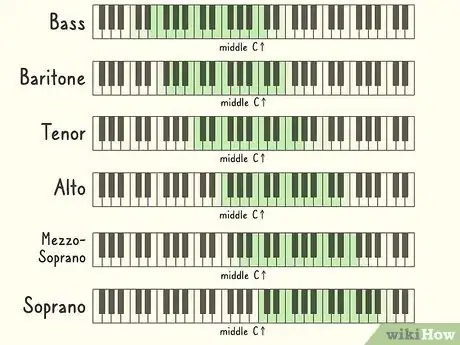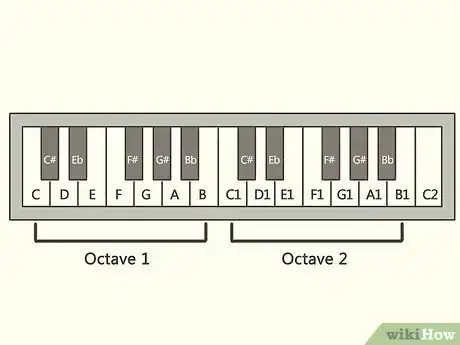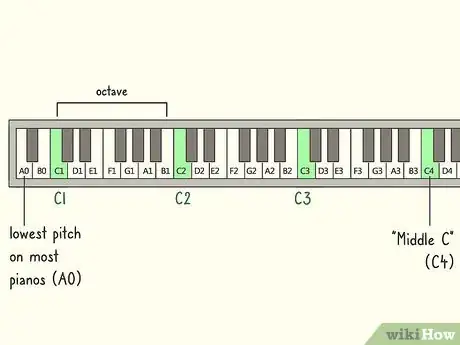This article was co-authored by Amy Chapman, MA. Amy Chapman MA, CCC-SLP is a vocal therapist and singing voice specialist. Amy is a licensed and board certified speech & language pathologist who has dedicated her career to helping professionals improve and optimize their voice. Amy has lectured on voice optimization, speech, vocal health, and voice rehabilitation at universities across California, including UCLA, USC, Chapman University, Cal Poly Pomona, CSUF, CSULA. Amy is trained in Lee Silverman Voice Therapy, Estill, LMRVT, and is a part of the American Speech and Hearing Association.
wikiHow marks an article as reader-approved once it receives enough positive feedback. This article received 14 testimonials and 86% of readers who voted found it helpful, earning it our reader-approved status.
This article has been viewed 1,342,915 times.
Finding your vocal range is important to singing properly. Although you may hear about vocalists with large ranges--Michael Jackson had nearly four octaves!--the majority of singers do not possess that kind of ability. Most people have between 1.5 and 2 octaves in their natural or modal voice and about one more octave in their other registers. With a little musical background and practice, you can easily figure out your vocal range and identify to which of the seven main voice types--soprano, mezzo-soprano, alto, countertenor, tenor, baritone, or bass--you belong.
Steps
Finding Your Lowest Notes
-
1Locate a piano or keyboard if possible. The easiest way to identify your range is with the assistance of a tuned instrument that you can play while you sing, like a piano or keyboard. If you do not have access to the physical instrument, download a piano app, such as Virtual Piano, on your smartphone, tablet, or other device as a substitute.
- Using an online piano on your laptop or device will give you access to a full simulated keyboard. It will also make it much easier to figure out which notes are your highest and lowest because the app will actually indicate the correct scientific pitch notation for a key as you play it.
-
2Find the lowest note you can sing in your normal (modal) voice for 3 seconds. Start by figuring out what the bottom end of your natural range is by locating the lowest note that you can sing comfortably without your voice croaking or cracking. You should also not have to “breathe” the note; that is, its tone quality should match that of the rest of your chest voice and not have a breathy or scratchy sound.[1]
- Instead of trying to pull your lowest note out of thin air, start by singing a higher note on a consistent vowel sound (like “ah” or “ee” or “oo”) and work your way down the scale into your lowest registers.
- If you’re a woman, start with an easy C4 (middle C on the piano), and work your way down the keys, matching each note until you hit your lowest. If you’re a man, play a C3 on the piano, and go down one key at a time from there.
- The goal is to find the lowest note you can still sing comfortably, so do not count notes that you cannot sustain.
Advertisement -
3Sing the lowest note you can, including breathing. Once you know how far down your voice can reach comfortably, try to go a bit lower, key by key and note by note. Breathy notes that you can sustain for 3 seconds count here, but croaky notes that you cannot hold do not.[2]
- For some singers their normal and breathy lowest notes may coincide. For others, they might not.
-
4Record your lowest notes. Once you have found your lowest normal-voiced note and the lowest one you can reach, write them down. Do so by identifying the piano key that corresponds to the note and then figuring out its correct scientific pitch notation.[3]
- For example, if the lowest note you can hit as you descend the scale is the second-to-last E on the keyboard, then you’d write down E2.
Finding Your Highest Notes
-
1Find the highest note you can sing in your normal (modal) voice for 3 seconds. You want to do the same thing you did for low notes but for the high end of the scale. Start with a higher note that you have no problem reaching, and ascend the scale key by key, but do not let yourself go into falsetto for this exercise.[4]
- If you’re a woman, start by playing a C5 and work your way up from there, key by key. If you’re a man, start by playing and matching a G3.
- You want to find the highest note you can hit without significantly changing your tone quality or the natural action of your vocal cords. If you hear a break or new breathiness in your voice or feel a difference in how your vocal cords are working to produce a note, then you’ve passed your modal register.
-
2Sing the highest note you can in falsetto. Most people can use falsetto, a mode in which your vocal cords remain open and relaxed and vibrate much less, to go lighter and higher than they can in their modal register. Now that you’ve found the highest note you can sing comfortably, relax your vocal cords, and see if you can push yourself a bit higher beyond your normal voice. Use your breathier, flute-like falsetto voice to find the highest notes you can reach without straining or cracking.[5]
- If you find that you can go further still beyond your falsetto to high notes that sound like whistles or squeals, you may well have a whistle voice, too. Your highest note will fall in that register.
-
3Record your highest notes. Now that you’ve located your highest notes, write them down in scientific pitch notation. Again, you want to track the highest notes you can reach without straining. Some of these notes may not sound wonderful before you’ve given them more practice, but include them as long as you can reach them comfortably.
- For example, if your highest note in your normal voice is the fourth ascending F on the keyboard, then you would write down F4 and so on.
Identifying and Classifying Your Range
-
1Identify your range and tessitura. You should now have four notes, two low and two high, written down in scientific pitch notation. Arrange them from lowest to highest. Put parentheses around the lowest and highest pitches and a dash in between the middle two. This notation expresses your full vocal range.
- For instance, if your collection of numbers reads D2, G2, F4, and B4, the correct notation for your range would read: (D2)G2-F4(B4).
- The outer two notes in parentheses represent your full range, that is, all the notes that your body is capable of producing.
- The two middle pitches (such as, “G2-F4” in the above example) represent your “tessitura,” that is, the range in which you can most comfortably sing using your normal voice. This is helpful to know when you are selecting the appropriate voice type for singing music.
-
2
-
3Calculate the octaves in your range. Every eight notes is one octave. A to A, for instance, is an octave. However, the last A will also count as the start of the next octave. You can, therefore, determine the number of octaves in your vocal range by counting the total number of notes between your highest and lowest pitches as sets of seven.[8]
- For example, if your lowest note was E2 and your highest note was E4, then you have a range of two octaves.
-
4Include the partial octaves as well. It’s normal, for example, for someone to have a range of 1.5 octaves in full voice. The reason for the half is because the person could only comfortably sing three or four notes in the next octave.
-
5Translate your vocal range into a voice type. Now that you have your vocal range written down using scientific pitch notation, you can use it to determine your vocal classification. Each voice type has an associated range; find which type aligns your full range.[9]
- The typical ranges for each voice type are as follows: soprano B3-G6, mezzo-soprano G3-A5, alto E3-F5, countertenor G3-C6, tenor C3-B4, baritone G2-G4, bass D2-E4.
- Your range may not fit perfectly into these standard ranges. Choose the one that fits closest.
- If your full range does not seem to fit obviously into a single voice type, use your tessitura instead to see which type it most closely aligns with. You want to pick the voice type in which you will be most comfortable singing.
- So, if you, for instance, have a range of (D2)G2-F4(A4), you would most likely be a baritone, the most common voice type for men.
EXPERT TIPAmy Chapman MA, CCC-SLP is a vocal therapist and singing voice specialist. Amy is a licensed and board certified speech & language pathologist who has dedicated her career to helping professionals improve and optimize their voice. Amy has lectured on voice optimization, speech, vocal health, and voice rehabilitation at universities across California, including UCLA, USC, Chapman University, Cal Poly Pomona, CSUF, CSULA. Amy is trained in Lee Silverman Voice Therapy, Estill, LMRVT, and is a part of the American Speech and Hearing Association.Vocal Coach
 Amy Chapman, MA
Amy Chapman, MA
Vocal CoachDid You Know? On any day your voice might be a couple of steps higher or lower,. It can especially vary due to illness, fatigue, or laryngitis.
Vocal Range Basics
-
1Learn about voice-type classifications. Many people have heard the terms soprano, tenor, or bass, but may not know exactly what they mean. In opera, voices are another instrument that must reach particular notes on demand, just like a violin or flute. Consequently, range classifications were developed to help identify voice types, which made it easier to cast opera singers for specific parts.
- While most people aren’t trying out for opera these days, being aware of your voice type helps you be more aware of the notes you can reach when performing other types of music, either solo or in choirs. Informally, it can even help you figure out which songs you can effectively cover when singing karaoke.
- The different voice types descending from highest to lowest are: soprano, mezzo-soprano, alto, countertenor, tenor, baritone, and bass. Each type has a typical associated vocal range.
-
2Figure out how to distinguish between vocal registers. You can divide range classifications into categories based on their respective vocal registers. Each register has a distinct timbre and is produced by a different action of your vocal cords. Accurately assessing your vocal range requires investigating the breadth of more than one type of vocal register, primarily those of your “modal” and “head” voices, and, in special cases, those of your “fry” and “whistle” voices.
- Your modal (or chest) voice is essentially your comfortable singing range when the vocal folds are in their natural manner of action. These are the notes you can reach without adding a low, breathy or high, falsetto quality to your voice. The range of notes that you can hit comfortably in your modal voice comprise your “tessitura.”
- Your head voice includes the high end of your range, produced with elongated vocal folds. It’s called “head voice” because it refers to those notes that feel the most resonant in one’s head and have a distinct ringing quality. Falsetto--the voice most people use when impersonating female opera singers--is included in the head-voice register.
- For some very low-voiced males, the lowest vocal register, called “vocal fry” is also added, but many people cannot even reach this low end. These notes are produced by floppy, vibrating vocal folds that create low, creaking or croaking notes.
- Just as the “vocal fry” register extends to super-low notes for some men, the “whistle register” extends to super-high notes for some women. The whistle register is an extension of the head voice, but its timbre is distinctly different, sounding not unlike, well, a whistle. Think: the infamous highest notes in a song like “Lovin’ You” by Minnie Riperton or “Emotions” by Mariah Carey.
-
3Make sense of octaves. An octave is the interval between two like notes (for instance B to B), the higher of which has twice the sound frequency of the lower. On a piano, octaves will span eight keys (excluding the black ones). One way to characterize your vocal range is by expressing the number of octaves that range spans.[10]
- The octave also corresponds with standard musical scales, which are typically comprised of eight ordered notes in ascending or descending order (for instance, C D E F G A B C). The interval between the first and last note of a scale is an octave.
-
4Recognize scientific pitch notation. Scientific pitch notation is a standardized way of writing and understanding musical notes using letters (that identify the notes, A through G) and ordinal numbers (that identify the correct octave, from low to high, starting with zero on up).
- For instance, the lowest pitch on most pianos is A0, making the next octave above it A1 and so on. What we deem “Middle C” on a piano is actually C4 in scientific pitch notation.
- Since the Key of C is the only major key with no sharps or flats (and, thus, uses only the white keys on a piano), scientific pitch notation counts octaves starting with “C” notes rather than “A” notes. This means that though the lowest pitch on the far left-hand side of a keyboard is A0, the first “C” that occurs two white keys to the right is C1 and so on. Hence, the first A note that appears higher than Middle C (C4) will be A4, not A5.
- The full expression of your vocal range will include three of four different scientific pitch notation numbers, including your lowest note, highest note in modal voice, and highest note in head voice. Those who can reach the vocal fry and whistle registers may have pitch notation numbers for those as well, always ranging from the lowest notation note to the highest.
Expert Q&A
Did you know you can get expert answers for this article?
Unlock expert answers by supporting wikiHow
-
QuestionHow do you determine your vocal range?
 Amy Chapman, MAAmy Chapman MA, CCC-SLP is a vocal therapist and singing voice specialist. Amy is a licensed and board certified speech & language pathologist who has dedicated her career to helping professionals improve and optimize their voice. Amy has lectured on voice optimization, speech, vocal health, and voice rehabilitation at universities across California, including UCLA, USC, Chapman University, Cal Poly Pomona, CSUF, CSULA. Amy is trained in Lee Silverman Voice Therapy, Estill, LMRVT, and is a part of the American Speech and Hearing Association.
Amy Chapman, MAAmy Chapman MA, CCC-SLP is a vocal therapist and singing voice specialist. Amy is a licensed and board certified speech & language pathologist who has dedicated her career to helping professionals improve and optimize their voice. Amy has lectured on voice optimization, speech, vocal health, and voice rehabilitation at universities across California, including UCLA, USC, Chapman University, Cal Poly Pomona, CSUF, CSULA. Amy is trained in Lee Silverman Voice Therapy, Estill, LMRVT, and is a part of the American Speech and Hearing Association.
Vocal Coach
-
QuestionIs it necessary to use a piano? I don't have any keyboard or piano in my home.
 Community AnswerAnother way to find the notes that a piano can provide is to find a piano app, such as the Pitch Pipe app, for your smartphone, iPad, or other relevant device. This is easy to use and the sound will still be effective.
Community AnswerAnother way to find the notes that a piano can provide is to find a piano app, such as the Pitch Pipe app, for your smartphone, iPad, or other relevant device. This is easy to use and the sound will still be effective. -
QuestionI'm female and my range is (E3)G3-D5(F5). What is my voice classification?
 Rosie DohertyCommunity AnswerI would say a lyric Contralto since you can go a little lower than most Contralto can and can hit the top of your range at F5. Most Conaltos can sing that note. Most go to E5 so i say in middle for Contralto.
Rosie DohertyCommunity AnswerI would say a lyric Contralto since you can go a little lower than most Contralto can and can hit the top of your range at F5. Most Conaltos can sing that note. Most go to E5 so i say in middle for Contralto.
Warnings
- These methods and resources use scientific pitch notation, with Middle C as C4. However, some music and musicians use different systems of pitch (such as calling Middle C C0 or C5). Your vocal range may be notated differently in these systems, so always be sure to check which one is being used.⧼thumbs_response⧽
- You should always warm up your voice with vocal exercises that take your voice from high to low registers before singing, especially when you will be using the edges of your vocal range.[11]⧼thumbs_response⧽
References
- ↑ Amy Chapman, MA. Vocal Coach. Expert Interview. 18 October 2019.
- ↑ Amy Chapman, MA. Vocal Coach. Expert Interview. 18 October 2019.
- ↑ https://www.youtube.com/watch?v=s_B8MFz72fI
- ↑ Amy Chapman, MA. Vocal Coach. Expert Interview. 18 October 2019.
- ↑ Amy Chapman, MA. Vocal Coach. Expert Interview. 18 October 2019.
- ↑ http://www.vocalist.org.uk/vocal_range_key.html
- ↑ http://www.vocalist.org.uk/vocal_range_key.html
- ↑ http://www.vocalist.org.uk/vocal_range_key.html
- ↑ https://www.musicnotes.com/now/tips/determine-vocal-range/
About This Article
To find your vocal range, start by singing a note on a consistent vowel sound, like "ah," "ee," or "oo," and working your way down the scale so you're singing lower and lower notes. Then, write down the lowest note you can sing without your voice cracking or croaking. Next, repeat the same process, but this time sing as high as you can, including the highest note you can sing in falsetto. Finally, use the lowest and highest notes you can sing to determine your vocal range. To learn how to classify your range once you know what notes you can comfortably sing, scroll down!






